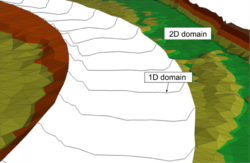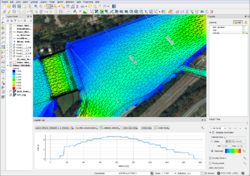Difference between revisions of "Global navigation satellite system (GNSS)"
Bendikhansen (talk | contribs) (Created page with "Note: I (Bendik) have copy-pasted this as it was from the report. I don't think it is very good or that it necessarily belongs here. Review/revise. =Quick summary= file:bas...") |
Bendikhansen (talk | contribs) |
||
| Line 16: | Line 16: | ||
GPS is often used as a synonym for all of the different systems | GPS is often used as a synonym for all of the different systems | ||
| − | <table border="1"> | + | <table style="height: 177px;" border="1" width="810"> |
<tr> | <tr> | ||
| − | <td style="text-align: center; | + | <td style="text-align: center; width: 122.4px;"> |
<p>System</p> | <p>System</p> | ||
</td> | </td> | ||
| − | <td style="text-align: center; | + | <td style="text-align: center; width: 250.4px;"> |
<p><strong>BeiDou</strong></p> | <p><strong>BeiDou</strong></p> | ||
</td> | </td> | ||
| − | <td style="text-align: center; | + | <td style="text-align: center; width: 122.4px;"> |
<p><strong>Galileo</strong></p> | <p><strong>Galileo</strong></p> | ||
</td> | </td> | ||
| − | <td style="text-align: center; | + | <td style="text-align: center; width: 122.4px;"> |
<p><strong>GLONASS</strong></p> | <p><strong>GLONASS</strong></p> | ||
</td> | </td> | ||
| − | <td style="text-align: center; | + | <td style="text-align: center; width: 160.8px;"> |
<p><strong>GPS</strong></p> | <p><strong>GPS</strong></p> | ||
</td> | </td> | ||
</tr> | </tr> | ||
<tr> | <tr> | ||
| − | <td style="text-align: center; | + | <td style="text-align: center; width: 122.4px;"> |
<p>Owner</p> | <p>Owner</p> | ||
</td> | </td> | ||
| − | <td style="text-align: center; | + | <td style="text-align: center; width: 250.4px;"> |
<p><strong>China</strong></p> | <p><strong>China</strong></p> | ||
</td> | </td> | ||
| − | <td style="text-align: center; | + | <td style="text-align: center; width: 122.4px;"> |
<p><strong>European Union</strong></p> | <p><strong>European Union</strong></p> | ||
</td> | </td> | ||
| − | <td style="text-align: center; | + | <td style="text-align: center; width: 122.4px;"> |
<p><strong>Russia</strong></p> | <p><strong>Russia</strong></p> | ||
</td> | </td> | ||
| − | <td style="text-align: center; | + | <td style="text-align: center; width: 160.8px;"> |
<p><strong>United States</strong></p> | <p><strong>United States</strong></p> | ||
</td> | </td> | ||
</tr> | </tr> | ||
<tr> | <tr> | ||
| − | <td style="text-align: center; | + | <td style="text-align: center; width: 122.4px;"> |
<p>Coverage</p> | <p>Coverage</p> | ||
</td> | </td> | ||
| − | <td style="text-align: center; | + | <td style="text-align: center; width: 250.4px;"> |
<p>Regional, global by 2020</p> | <p>Regional, global by 2020</p> | ||
</td> | </td> | ||
| − | <td style="text-align: center; | + | <td style="text-align: center; width: 122.4px;"> |
<p>Global by 2020</p> | <p>Global by 2020</p> | ||
</td> | </td> | ||
| − | <td style="text-align: center; | + | <td style="text-align: center; width: 122.4px;"> |
<p>Global</p> | <p>Global</p> | ||
</td> | </td> | ||
| − | <td style="text-align: center; | + | <td style="text-align: center; width: 160.8px;"> |
<p>Global</p> | <p>Global</p> | ||
</td> | </td> | ||
</tr> | </tr> | ||
<tr> | <tr> | ||
| − | <td style="text-align: center; | + | <td style="text-align: center; width: 122.4px;"> |
<p>Status</p> | <p>Status</p> | ||
</td> | </td> | ||
| − | <td style="text-align: center; | + | <td style="text-align: center; width: 250.4px;"> |
<p>Basic service by 2018, to be complete by H1 2020</p> | <p>Basic service by 2018, to be complete by H1 2020</p> | ||
</td> | </td> | ||
| − | <td style="text-align: center; | + | <td style="text-align: center; width: 122.4px;"> |
<p>Operating since 2016, 2020 completion</p> | <p>Operating since 2016, 2020 completion</p> | ||
</td> | </td> | ||
| − | <td style="text-align: center; | + | <td style="text-align: center; width: 122.4px;"> |
<p>Operational</p> | <p>Operational</p> | ||
</td> | </td> | ||
| − | <td style="text-align: center; | + | <td style="text-align: center; width: 160.8px;"> |
<p>Operational</p> | <p>Operational</p> | ||
</td> | </td> | ||
</tr> | </tr> | ||
<tr> | <tr> | ||
| − | <td style="text-align: center; | + | <td style="text-align: center; width: 122.4px;"> |
<p>Precision</p> | <p>Precision</p> | ||
</td> | </td> | ||
| − | <td style="text-align: center; | + | <td style="text-align: center; width: 250.4px;"> |
<p>10 (public) 0.1m (encrypted)</p> | <p>10 (public) 0.1m (encrypted)</p> | ||
</td> | </td> | ||
| − | <td style="text-align: center; | + | <td style="text-align: center; width: 122.4px;"> |
<p>1m (public) 0.01m (encrypted)</p> | <p>1m (public) 0.01m (encrypted)</p> | ||
</td> | </td> | ||
| − | <td style="text-align: center; | + | <td style="text-align: center; width: 122.4px;"> |
<p>4.5m - 7.4m</p> | <p>4.5m - 7.4m</p> | ||
</td> | </td> | ||
| − | <td style="text-align: center; | + | <td style="text-align: center; width: 160.8px;"> |
<p>15m (no DGPS or WAAS)</p> | <p>15m (no DGPS or WAAS)</p> | ||
</td> | </td> | ||
Revision as of 14:28, 24 June 2019
Note: I (Bendik) have copy-pasted this as it was from the report. I don't think it is very good or that it necessarily belongs here. Review/revise.
Contents
Quick summary
Developed by: USA, EU, China, Russia
Date:
Type: Method
Suitable for the following [[::Category:Measures|measures]]:
Introduction
GPS is often used as a synonym for all of the different systems
|
System |
BeiDou |
Galileo |
GLONASS |
GPS |
|
Owner |
China |
European Union |
Russia |
United States |
|
Coverage |
Regional, global by 2020 |
Global by 2020 |
Global |
Global |
|
Status |
Basic service by 2018, to be complete by H1 2020 |
Operating since 2016, 2020 completion |
Operational |
Operational |
|
Precision |
10 (public) 0.1m (encrypted) |
1m (public) 0.01m (encrypted) |
4.5m - 7.4m |
15m (no DGPS or WAAS) |
Application
The 1D model of BASEMENT is based on river cross sections and its main application are river reaches where the level of detail is less important. The 2D model uses a triangular computational grid to reproduce the topography and can be applied to more detailed and complex problems than the 1D model, e.g. the inundation or river bar formation. BASEMENT supports Windows as well as Linux platforms and includes a graphical user interface (GUI) which supports the user during the model setup and simulation process (Figure 2). For grid generation, the QGIS plugin BASEmesh is provided by the developers and for visualization of the results, among others, the QGIS plugin Crayfish (QGIS 2.8) from Lutra Consulting (https://www.lutraconsulting.co.uk) can be used (Figure 3).
Other information
In addition to the use on regular Windows and Linux workstations, the upcoming version 3.0 of BASEMENT (March 2019) is designed to run on graphical processing units (GPUs) and distributed memory computer clusters allowing engineers to tackle problems with very large computational domains or long simulation time.
Relevant literature
- Vetsch D., Siviglia A., Caponi F., Ehrbar D., Gerke E., Kammerer S., Koch A., Peter S., Vanzo D., Vonwiller L., Facchini M., Gerber M., Volz C., Farshi D., Mueller R., Rousselot P., Veprek R., Faeh R. 2018. System Manuals of BASEMENT, Version 2.8. Laboratory of Hydraulics, Glaciology and Hydrology (VAW). ETH Zurich. Available from http://www.basement.ethz.ch.
Contact information
Website (download, tutorials, etc.): http://www.basement.ethz.ch
Email: basement@ethz.ch


